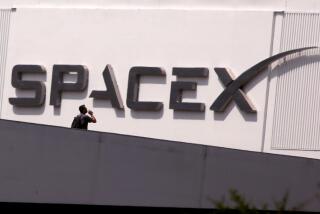Critic’s Notebook: Apple’s new campus will be a retrograde cocoon
In early June, Apple CEO Steve Jobs made what amounted to an extended architectural sales pitch when he appeared before the City Council in Cupertino to present the details of a planned new headquarters for the company he co-founded in 1976. Jobs showed renderings of a sleek, glimmering building, ring-shaped and four stories high, set gently into a lush green landscape.
The members of the council found the pitch persuasive, to say the least. (“The word ‘spectacular’ would be an understatement,” one said.) As Gawker put it, their enthusiastic, borderline sycophantic reaction was proof that “politicians respond as readily to Jobs’ techniques as computer geeks.”
You can understand why the city, especially in this economy, would want to maintain the happiest of relationships with Apple, based in Cupertino on a parcel of land — known as the Infinite Loop campus — less than a mile west of the new headquarters. Still, had the members of the council been in an even slightly more inquisitive mood, there are a number of questions they might have asked Jobs about the forthcoming building, which will hold 12,000 Apple employees. The piece of architecture he was describing for them, after all, is practically bursting with contradictions.
Though the planned building has a futuristic gleam — Jobs told the council “it’s a little like a spaceship landed” — in many ways it is a doggedly old-fashioned proposal, recalling the 1943 Pentagon building as well as much of the suburban corporate architecture of the 1960s and ‘70s. And though Apple has touted the new campus as green, its sprawling form and dependence on the car make a different argument.
Now that Jobs, who underwent surgery for pancreatic cancer in 2004 and a liver transplant two years ago, has announced he is stepping down as Apple CEO, the new headquarters building has taken on the symbolism of an architectural curtain call. It is the last of Apple’s products that Jobs — whose influence on contemporary design is wide-ranging and justifiably celebrated — is likely to help shape. As such it seems ripe for the kind of analysis that he and the company are eager to forestall.
One question the council members might have asked Jobs is simple: Who’s your architect? Jobs likes to promote the notion that he is personally involved in designing virtually all of Apple’s buildings — including the impressive Apple retail stores that first opened in 2001 and were largely produced by the architecture firm Bohlin Cywinski Jackson. In his appearance before the City Council he said Apple had “hired some great architects to work with — some of the best in the world, I think.” But he never mentioned the high-wattage name of Norman Foster or the London firm Foster + Partners, whose logo is stamped on the preliminary plans for the campus. (Those plans are available for download on Cupertino’s website, cupertino.org.)
It is a measure of Jobs’ tight grip on Apple’s reputation for in-house design innovation that even after hiring a celebrity architect like Foster he would keep that architect’s name under wraps; even now, three months after Jobs took the plans public in that council meeting, the Apple press office refuses to confirm that Foster + Partners indeed designed the project.
In a broader sense, the council might have engaged Jobs in a conversation about the role this massive proposed building — holding 2.8 million square feet of interior space — promises to play in Cupertino’s civic future. When the designs first surfaced online, and a few critics noted their strikingly detached and anti-urban character, defenders of Apple responded by saying that those comments suggested a misreading of Silicon Valley’s history.
That’s a fair point: The legendary 1939 founding of Hewlett-Packard happened in the garage of a single-family house on a quiet street in Palo Alto, and in fact Apple bought the land for its new campus from that company. Jobs spent much of his childhood in Cupertino. Apple, even more than most high-tech companies, makes products lusted over by young urbanites around the world from deep within a quiet, low-rise realm, far from any skyscraper or subway line. Its Infinite Loop campus, like most Silicon Valley headquarters, is a relatively undistinguished collection of modestly sized buildings.
The more interesting question is whether a place like Cupertino can maintain its low-density sprawl in future decades, as the Bay Area’s population continues to grow, and whether the council’s enthusiasm for the new Apple headquarters can be read as an endorsement of a car-dependent approach to city and regional planning that might have made sense in the 1970s but will seem irresponsible or worse by 2050.
In its dedication to existing corporate landscape of Silicon Valley, the planned Apple headquarters is a classic example of what Louise A. Mozingo, in a book due out next month from MIT Press, calls “pastoral capitalism.” Tracing the history of the postwar suburban corporate campus, Mozingo, an associate professor in the landscape architecture department at UC Berkeley, calls it very much a product of its era, symbolizing “a particular moment of American economic history” when our corporations were gaining in wealth and global reach and increasingly fleeing the city for the privacy and elbow room of the suburbs.
The rise of the corporate estate, she writes, also reflected the Jeffersonian mores of a nation that from its earliest decades loved “to turn its back on cities and stake a claim on the suburban pastoral idyll — isolated, proprietary, verdant, and disengaged from civic space.” Those adjectives, of course, perfectly describe the planned Apple headquarters. There are unmistakable echoes in Apple’s new building of the headquarters of Merck, the pharmaceutical giant, in suburban New Jersey, a campus designed by Kevin Roche John Dinkeloo and Associates.
Even more than low-density tract housing, Mozingo argues, the pastoral corporate campus “precludes the concentration of population that makes public transportation feasible for governments and users.” And even if suburbs like Cupertino decide to make tentative moves in the direction of greater density and better transit, the architecture of the corporate estate — the land it eats up and the automobile infrastructure it requires — helps fix in place land-use patterns that are tough to dislodge.
Mozingo wraps up her book with an extended critique of the mind-set that corporate architecture of this kind seems to promote. “If all you see in your workday are your co-workers and all you see out your window is the green perimeter of your carefully tended property,” she writes, and you drive to and from work in the cocoon of your private car, “the notion of a shared responsibility in the collective metropolitan realm is predictably distant.”
It’s always dangerous to draw too neatly the distinction between the endlessly sprawling suburbs and the dense, vertical city; more and more the lines between the categories are blurred. The rise of Los Angeles over the last century is itself a powerful argument against the idea that low-rise development precludes the kind of vitality or diversity we associate with the most progressive cities.
Still, the new Apple campus, which the company describes as “a serene and secure environment” for its employees, keeps itself aloof from the world around it to a degree that is unusual even in a part of California dominated by office parks. The proposed building is essentially one very long hallway connecting endlessly with itself.
christopher.hawthorne@latimes.com
More to Read
Inside the business of entertainment
The Wide Shot brings you news, analysis and insights on everything from streaming wars to production — and what it all means for the future.
You may occasionally receive promotional content from the Los Angeles Times.











